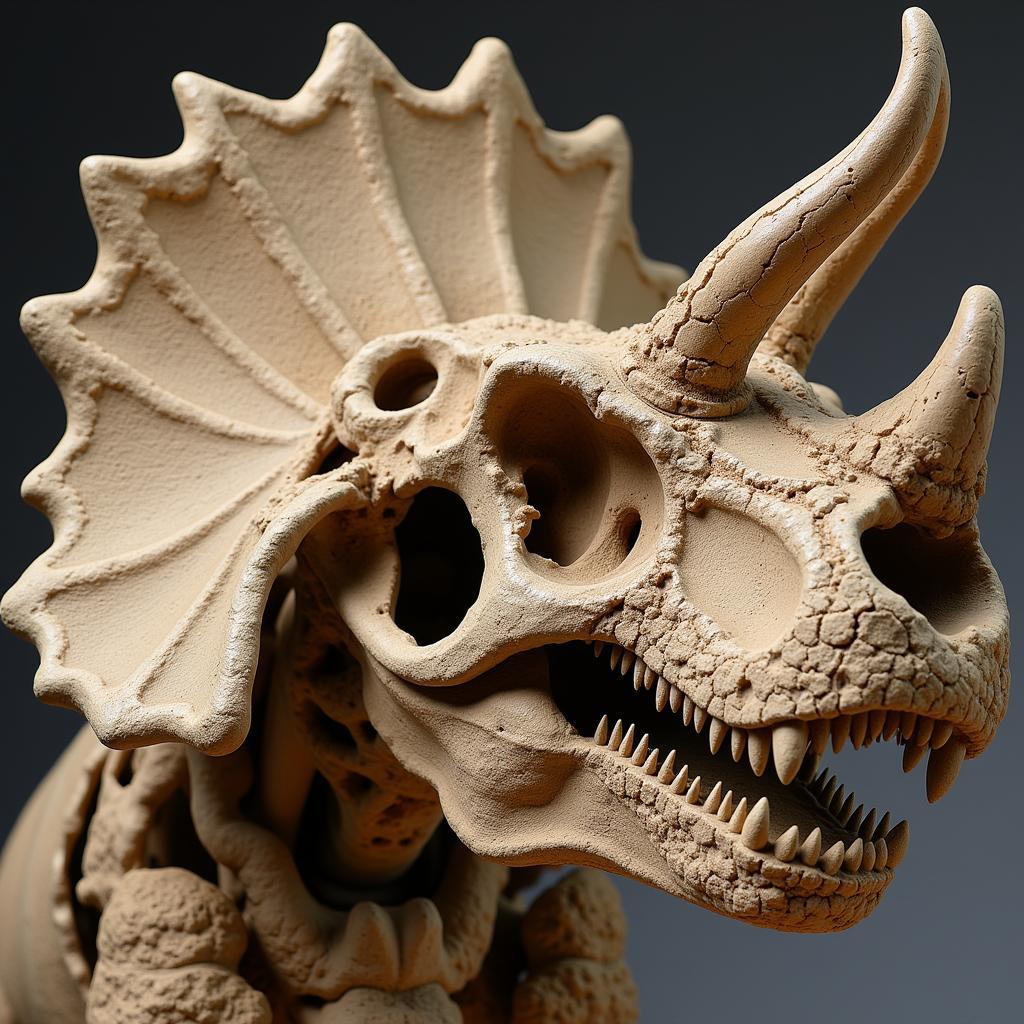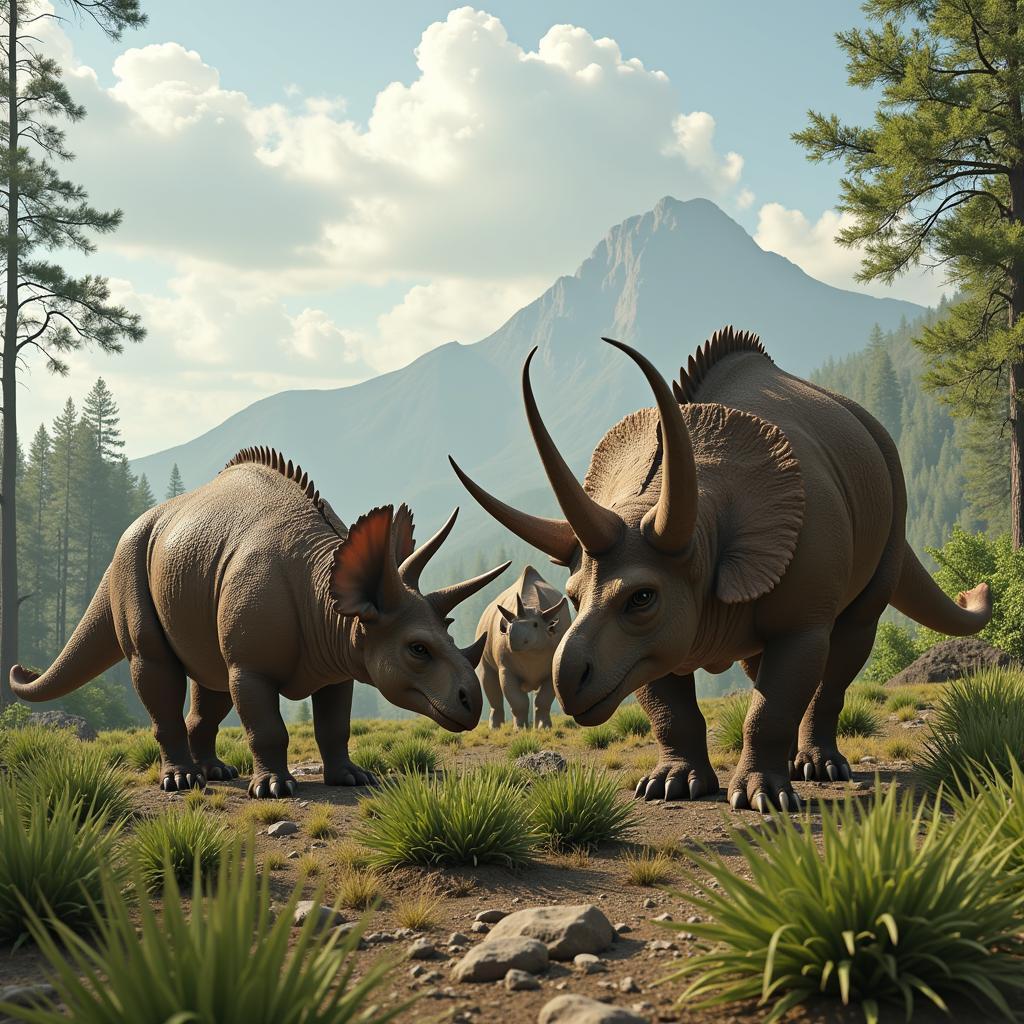The imposing figure of the Triceratops, with its three horns and bony frill, has captivated the imaginations of paleontologists and dinosaur enthusiasts alike. As one of the most iconic dinosaurs to have roamed the Earth, the Triceratops continues to be a subject of intense research, yielding fascinating insights into its life and the prehistoric world it inhabited.
 Fossilized Skull of a Triceratops
Fossilized Skull of a Triceratops
Digging Deeper: What Can Triceratops Research Tell Us?
Triceratops Research encompasses a wide array of disciplines, from paleontology and geology to biology and even physics. By studying fossilized bones, footprints, and even fossilized dung, scientists can piece together a remarkably detailed picture of these prehistoric giants. Here’s a glimpse into the world of Triceratops research:
- Anatomy and Physiology: Triceratops research has revealed fascinating details about the dinosaur’s anatomy, including its massive size, powerful legs, and unique skull structure. Scientists can estimate muscle mass, gait, and even potential vocalizations based on bone structure and comparisons with modern-day animals.
- Diet and Behavior: Analysis of fossilized teeth and jaw structure suggests that Triceratops was herbivorous, likely feeding on ferns, cycads, and other low-lying vegetation. The function of their horns and frills is still debated, with theories ranging from defense against predators to display and intraspecies combat.
- Environment and Ecology: The discovery of Triceratops fossils in specific geological formations provides valuable clues about the environment and ecosystem they inhabited. By analyzing the surrounding rock layers and fossilized plant and animal remains, researchers can reconstruct the flora, fauna, and climate of the Late Cretaceous period.
Debates and Discoveries: The Evolving Landscape of Triceratops Research
Like any scientific field, Triceratops research is constantly evolving. New discoveries and interpretations can challenge existing theories and lead to revised understandings of these ancient creatures.
- The Torosaurus Debate: One ongoing debate centers around the relationship between Triceratops and another horned dinosaur, Torosaurus. Some paleontologists believe that Torosaurus, with its larger, more fenestrated frill, may actually represent a mature Triceratops rather than a distinct species.
- Growth Stages and Variation: Research on Triceratops fossils of different ages has revealed significant changes in skull morphology throughout their lifespan. This has led to a better understanding of dinosaur growth stages and individual variation within the species.
- Triceratops and the End of an Era: As one of the last non-avian dinosaurs, Triceratops research also sheds light on the events leading up to the Cretaceous-Paleogene extinction event, which wiped out the dinosaurs approximately 66 million years ago.
 A Herd of Triceratops Grazing in a Prehistoric Landscape
A Herd of Triceratops Grazing in a Prehistoric Landscape
Unanswered Questions: The Future of Triceratops Research
Despite decades of research, many questions about Triceratops remain unanswered, fueling ongoing investigations and captivating the scientific community.
- The True Function of Horns and Frills: While defense and display are the leading theories, the exact function of Triceratops’ horns and frill is still debated. Further research into biomechanics, injury patterns, and comparative anatomy may provide more definitive answers.
- Social Behavior and Herding: Did Triceratops live in herds, and if so, what was their social structure? Fossil evidence suggests the possibility of herding behavior, but more research is needed to understand their social interactions and group dynamics.
- Triceratops in the Context of the Late Cretaceous: How did Triceratops interact with other dinosaurs, particularly predators like Tyrannosaurus Rex? Further research into predator-prey relationships, niche partitioning, and ecosystem dynamics can provide a more complete picture of Triceratops’ place in the Late Cretaceous world.
Conclusion: Triceratops Research – A Journey Through Time
The study of Triceratops offers a captivating glimpse into Earth’s prehistoric past. From their massive skeletons to the mysteries surrounding their behavior, Triceratops research continues to fuel our curiosity about dinosaurs and their world. As new technologies emerge and fossil discoveries come to light, we can expect even more exciting revelations about these iconic creatures in the years to come.
FAQ
1. How big was a Triceratops?
Adult Triceratops could reach up to 30 feet in length and weigh up to 12 tons, making them one of the largest horned dinosaurs.
2. What did Triceratops eat?
Triceratops were herbivores, likely feeding on ferns, cycads, and other low-lying vegetation.
3. Did Triceratops live in herds?
Fossil evidence suggests that Triceratops may have lived in herds, but more research is needed to confirm this.
4. Why did Triceratops go extinct?
Triceratops, along with all other non-avian dinosaurs, went extinct approximately 66 million years ago in the Cretaceous-Paleogene extinction event, likely caused by an asteroid impact.
5. Where can I see Triceratops fossils?
Triceratops fossils can be found in museums around the world, including the American Museum of Natural History, the Smithsonian National Museum of Natural History, and the Natural History Museum in London.
Do you have more questions about the enigmatic Triceratops or other aspects of cretaceous research? Explore the fascinating world of paleontology and discover the secrets of these prehistoric giants.
For inquiries and assistance, contact us:
Phone: 0904826292
Email: research@gmail.com
Visit us at: No. 31, Alley 142/7, P. Phú Viên, Bồ Đề, Long Biên, Hà Nội, Việt Nam.
Our team is available 24/7 to assist you.